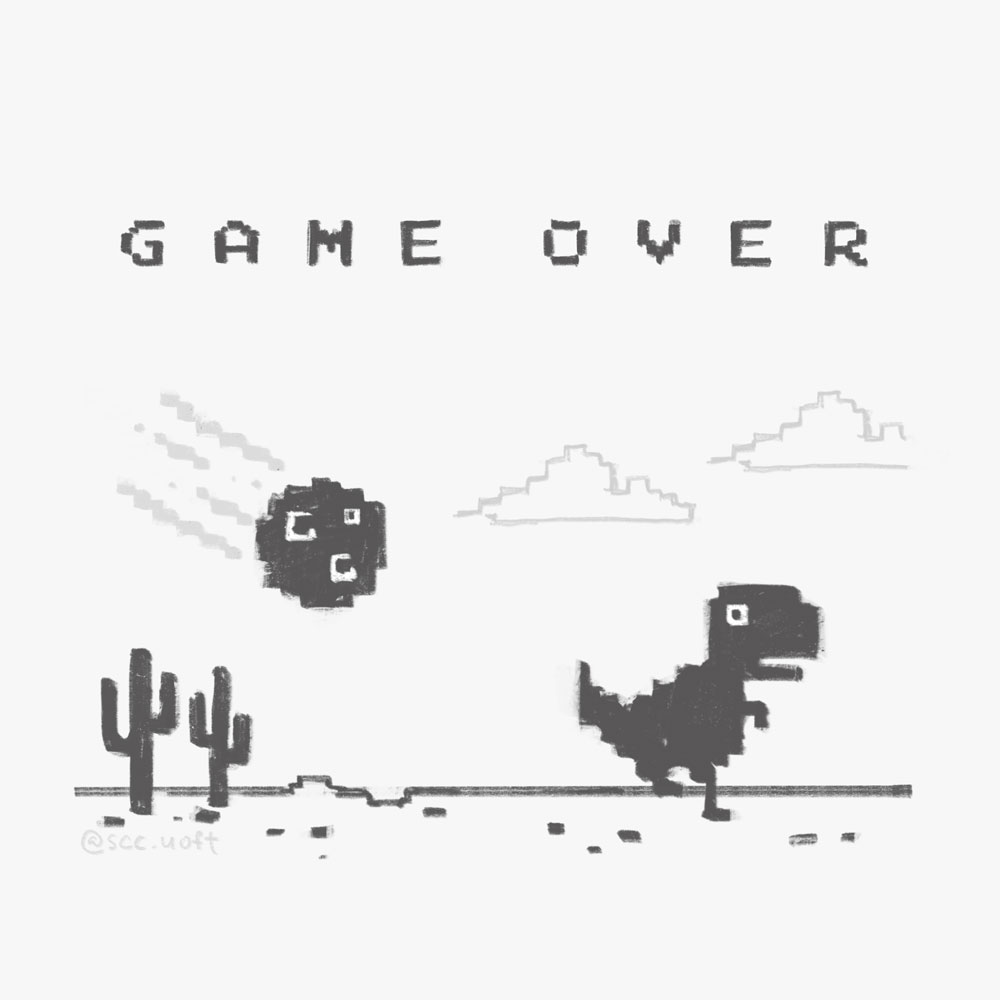
Written by Iyeh Mohammadi and Maia Dall’Acqua
Illustrated by Amy Zhang
For millions of years, dinosaurs dominated the Earth in the time period we call the Mesozoic Era (also known as the Age of Reptiles) and it seemed like nothing could end their reign. But 66 million years ago, the planet was changed forever. The Age of Reptiles came to a jolting halt after a disaster killed millions of species and wiped out three quarters of all life on Earth. What could’ve caused this? This question has plagued scientists for years and many theories have been thrown about to explain what happened, from volcanic eruptions to aliens. The most popular theory is that a massive meteor strike is what caused this catastrophic event, but how do we know for sure that it was the culprit?
One of the first clues is in the K-Pg boundary. This boundary is 66 million years old and is essentially a thin layer of rock in the Earth’s crust that marks the end of the Mesozoic Era as no dinosaur fossils have ever been found above it. What’s odd is that unlike its surrounding layers, this boundary has lots of iridium, a metal that’s quite uncommon on Earth but can make up a large part of meteors, and tektites, little glass beads that rain down to the ground after molten rocks are blown up into the air. All this points to a meteor impact with planet-wide consequences, but where did it happen?
The answer lies off the coast of Mexico in the Yucatán Peninsula. While the suspected site isn’t a popular vacation spot, its location is well known to scientists: the Chicxulub crater. Discovered in the 1970s, it is a 93 miles-long crater buried near the coast that just happens to be of the right size and age to have been caused by the theorized meteor. In fact, in 2016 and even more recently in September 2019, rock samples taken from the crater prove just that: 66 million years ago, a giant meteor struck Earth at Chicxulub and ejected enough vaporised rock and gases in the atmosphere to be deadly and drastically alter the climate for years to come.
Based on these samples, we can create a rough timeline of events on the day the dinosaurs died. After the Chicxulub meteor hit the Earth, it started a chain of catastrophic effects. First, raging forest fires would’ve fried even the largest and fastest dinosaurs, releasing massive amounts of smoke into the atmosphere. This smoke along with dust and debris from the impact blocked out the sunlight, plunging the planet into a frigid winter that killed whatever plants and animals that survived the toxic gases from the impact. We weren’t alive at the scene when this happened, but nature itself has beared witness. In March 2019, a stunning site was discovered in North Dakota where fossils capture what happened on the day of impact like a photograph. Shockwaves from the impact rocked the planet and drove tons of seawater upriver onto land, depositing both freshwater and oceanic fish. As debris from the explosion fell, the sediments buried choking animals and burning plants alike, trapping them in the calamity and creating a historic image of that fatal day.
Is this proof enough to come to a verdict? While new research is always being done on the extinction, many questions remain about the meteor and what long-term effects it had on the Earth and its ecosystems. But many pieces of the puzzle have fallen into place, and scientists are certain that we are on the right path to uncovering the mysterious catastrophe that occurred millions of years before humans inhabited the Earth. And fortunately for us, there aren’t any dinosaurs around to chase us while we’re at it.
Sources:
- https://en.wikipedia.org/wiki/Cenozoichttps://en.wikipedia.org/wiki/Mesozoichttps://en.wikipedia.org/wiki/Cretaceous–Paleogene_extinction_event
- https://www.nationalgeographic.com/science/prehistoric-world/dinosaur-extinction/
- https://science.sciencemag.org/content/354/6314/878https://www.newyorker.com/magazine/2019/04/08/the-day-the-dinosaurs-died
- https://www.pnas.org/content/116/17/8190
- https://www.pnas.org/content/116/39/19342
- https://www.smithsonianmag.com/science-nature/dinosaur-killing-asteroid-impact-chicxulub-crater-timeline-destruction-180973075/
- https://www.nationalgeographic.com/science/2019/09/last-day-dinosaurs-reign-captured-stunning-detail/